
2022 Hunga Tonga Eruption and Tsunami Wikipedia
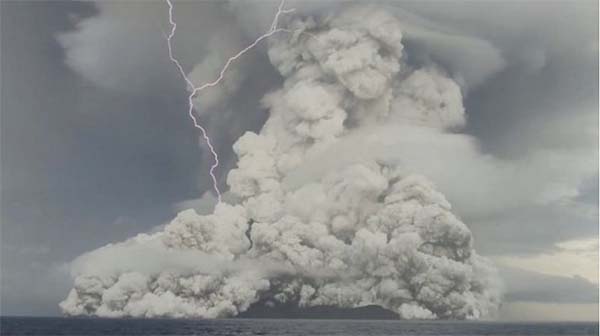

2022 Hunga Tonga Eruption and Tsunami Wikipedia

Hunga Tonga-Hunga is a submarine volcano in the South Pacific located about 30 km (19 mi) south of the submarine volcano of Fonuafo'ou and 65 km (40 mi) north of Tongatapu, Tonga's main island.
It is part of the highly active Kermadec-Tonga subduction zone and its associated volcanic arc, which extends from New Zealand north-northeast to Fiji, and is formed by the subduction of the Pacific Plate under the Indo-Australian Plate. It lies about 100 km (62 mi) above a very active seismic zone.
The volcano rises around 2,000 m from the seafloor and has a caldera which - on the eve of the 2022 eruption - was roughly 150 m below sea level and 4 km at its widest extent. The only major above-water part of the volcano are the twin uninhabited islands of Hunga Tonga and Hunga Ha'apai, which are respectively part of the northern and western rim of the caldera.
As a result of the volcano's eruptive history, the islands existed as single landmass from 2015 to 2022: they were merged by a volcanic cone in a VEI 2 volcanic eruption in 2014-2015, and were separated again by a more explosive eruption in 2022, which also reduced the islands in size.
Its most recent eruption in January 2022 generated a tsunami that reached as far as the coasts of Japan and of the Americas and a volcanic plume that reached 58 km (36 mi) into the mesosphere.
As of May 2023 it is the largest volcanic eruption of the 21st century. The Krakatoa eruption of 1883 is the only one that rivals the atmospheric disturbance produced by Hunga Tonga.
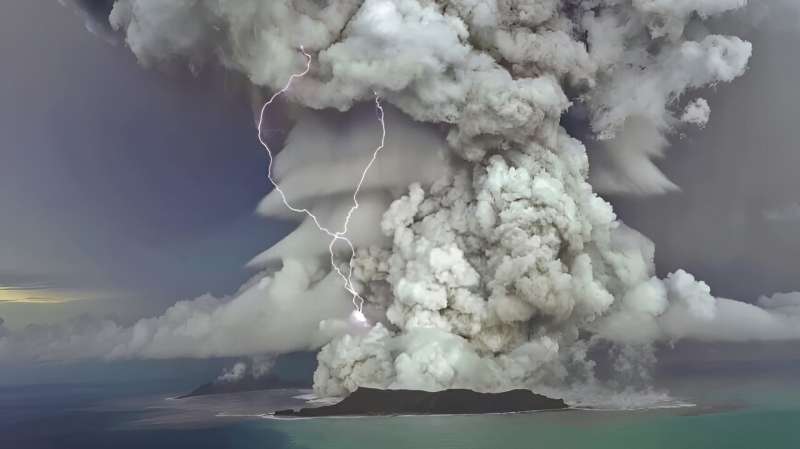
Something Weird Happened 15 Minutes Before the Giant Tonga Eruption of 2022 - It was preceded by a seismic wave that shot across Earth's surface - November 5, 2024
Underwater Santorini volcano eruption 520,000 years ago was 15 times bigger than record-breaking Tonga eruption Live Science - January 26, 2024
Tonga volcano eruption was fueled by 2 merging chambers that are still brimming with magma Live Science - December 19, 2023
Study examines how massive January 15, 2022 eruption changed stratosphere chemistry and dynamics and produced a shock wave felt around the world triggering tsunamis in Tonga, Fiji, New Zealand, Japan, Chile, Peru and the United States PhysOrg - November 22, 2023
New study shows Hunga-Tonga Hunga-Ha'apai eruption depleted ozone layer PhysOrg - October 21, 2023
Tonga Eruption's Vast Impact: A New Gap In Earth's Ozone IFLScience - October 21, 2023
Tonga volcano triggered seafloor debris stampede BBC - September 8, 2023
The 2022 Tonga Eruption Created a Very Rare 'Super Plasma Bubble' in The Ionosphere Science Alert - May 26, 2023
Eruption of Tonga underwater volcano found to disrupt satellite signals halfway around the world PhysOrg - May 22, 2023
Study reveals presence of Hunga Tonga eruption aerosols in Northern Hemisphere stratospheric westerlies PhysOrg - May 9, 2023
The Tonga underwater volcanic eruption rivaled the strength of the largest U.S. nuclear bomb and produced a "mega-tsunami" nearly the height of a 30-story skyscraper Live Science - May 2, 2023
Tonga's massive volcanic eruption wiped out unique, never-before-seen life-forms Live Science - January 31, 2023
Very strong M7.3 earthquake hits Tonga Islands region, Tsunami Advisory in effect The Watchers - November 11, 2022
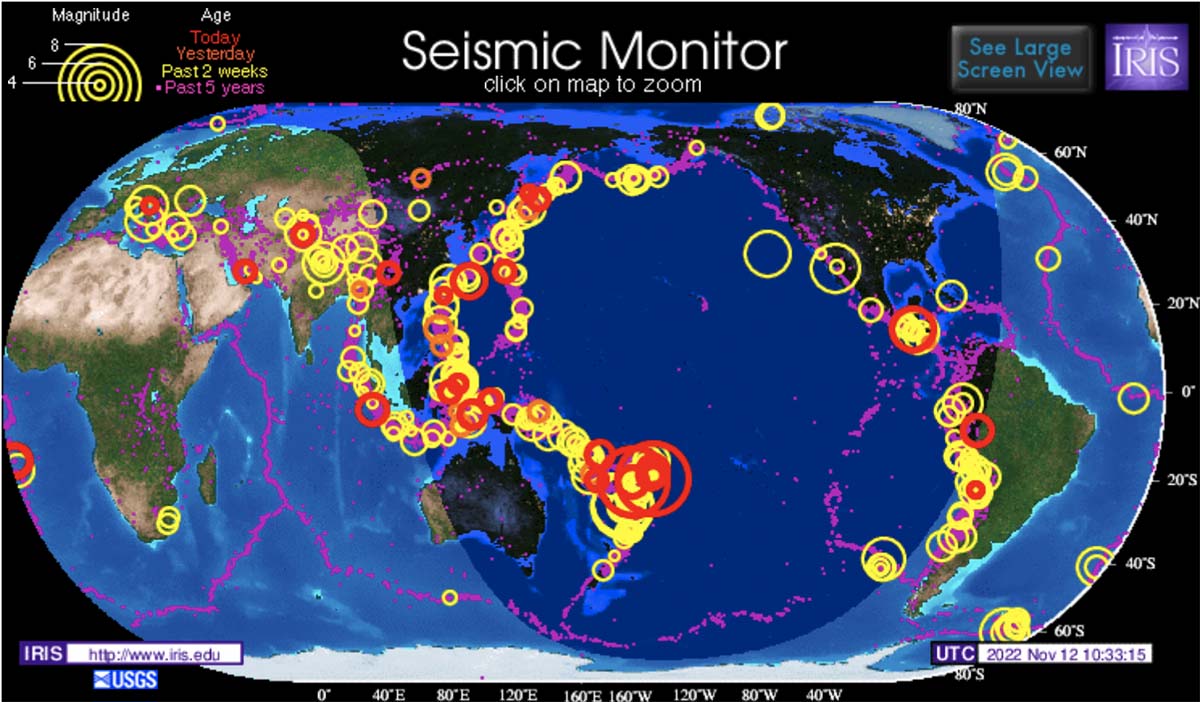
Hunga Tonga-Hunga Ha'apai Eruption Released The Highest Volcanic Plume Ever Recorded Science Alert - November 5, 2022
'Baby' island appears in Pacific Ocean after underwater volcano erupts CNN - September 24, 2022
A Global Tsunami: How Did the Tonga Tsunami Jump From Ocean to Ocean? SciTech Daily - August 22, 2022
Tonga volcano eruption released more energy than the most powerful nuclear bomb PhysOrg - August 22, 2022
New Zealand Prof Shane Cronin has just returned from snorkeling over the Tonga underwater volcano that blew its top in January BBC - April 13, 2022
Tonga underwater volcano eruption shattered two records Live Science - February 24, 2022
Tonga eruption equivalent to hundreds of Hiroshimas: NASA PhysOrg - January 24, 2022
Tonga eruption was so intense, it caused the atmosphere to ring like a bell Live Science - January 24, 2022
Tonga volcano: Plume reached half-way to space BBC - January 23, 2022
The Tonga Volcanic Eruption Was So Powerful It Sent Ripples Out Into Space Science Alert - January 23, 2022
Tonga: Survivor tells of sea escape from tsunami-struck island BBC - January 22, 2022
When an enormous underwater volcanic eruption occurred in the South Pacific near Tonga on Saturday, satellites were in position to capture what had happened BBC - January 16, 2022
Tsunami Waves Over 4 Feet High Hit Pacific Coast after Major Eruption near Tonga Weather.com - January 15, 2022
Waves between 1 and 4 feet were reported from California to Alaska Saturday after a tsunami advisory was issued because of a volcanic eruption in the South Pacific. The advisory was issued for Hawaii and the U.S. Pacific Coast including California, Oregon, Washington and parts of Alaska early Saturday morning after the undersea volcano erupted near the island nation of Tonga. A wave of 4.3 feet was reported in Port San Luis California, according to the National Weather Service. Large waves were also reported in King Cove, Alaska, La Push, Washington, and several other locations. Two people were transported to the hospital after being swept into the water Saturday afternoon at San Gregorio State Beach, according to local fire officials. One was taken by helicopter.
A toxic cloud spewing from an erupting volcano in Tonga could dump acid rainfall across the Pacific kingdom, potentially poisoning drinking water and damaging people's skin and eyes, emergency services have warned PhysOrg - December 22, 2021
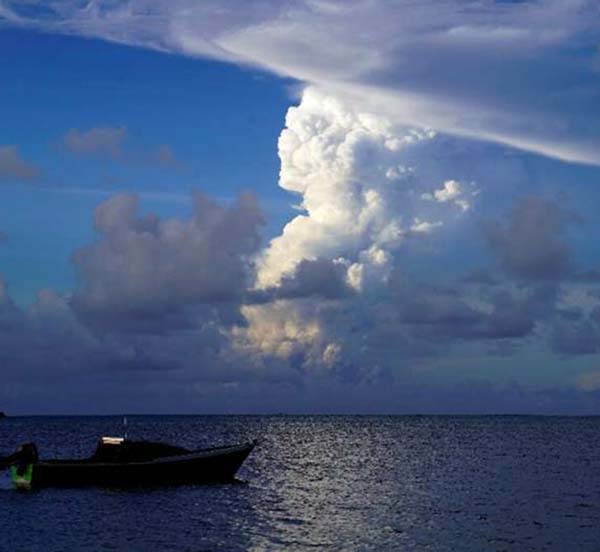
Police reported no injuries from the eruption but TGS said late Tuesday that the dust and gas could result in acidic rainfall if mixed with water in the atmosphere. It advised residents to remove guttering systems from their rainwater storage systems until the all-clear was given .
Underwater volcanoes: How ocean color changes can signal an imminent eruption PhysOrg - January 24, 2022
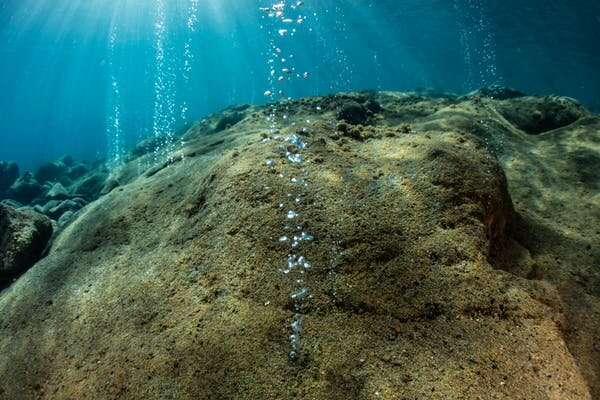
The scale of a recent volcano eruption took the people of Tonga by surprise. Scientists monitoring the submarine volcano, Hunga Tonga-Hunga Ha'apai, were likewise caught off-guard, failing to foresee an explosion which would unleash a Pacific-wide tsunami. Scientists estimate that the blast may have been the loudest terrestrial event since the eruption of Krakatoa in 1883, while an organization that monitors nuclear tests went so far as to declare it the biggest thing they have ever seen.
The volcano had been active a few times in recent years, with moderate eruptions that only amounted to local disturbance. The lack of warning for an event this large left many wondering if there might be other volcanoes beneath the ocean similarly primed to blow. To study volcanoes and interpret whether they're likely to erupt, scientists mount them with different kinds of measuring equipment. Seismometers help them detect small tremors caused by magma moving under the ground, while gas samplers and thermal cameras can be used to track changes in gas concentrations and temperature as magma ascends from the depths.
It's rarely acknowledged, however, that most volcanic activity on Earth occurs beneath the sea. Submarine volcanoes are pretty much ubiquitous in all of the world's major oceans and it's estimated that 75% of the Earth's magma output comes from mid-ocean ridges. To make things trickier, many known submarine volcanoes are found far from land, and being underwater prevents scientists from observing any changes by conventional means. So how do we monitor them? Scientists have managed to install equipment that detects tell-tale tremors on the sea bed before.